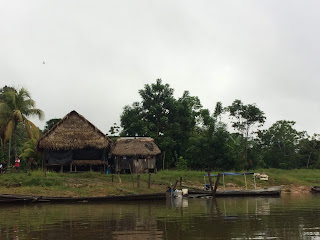It's hard to put your finger on what might cause this feeling. The lack of modernity coupled with the people's satisfaction with their lifestyle is clearly a contender. Perhaps knowing that only 40 years ago these people survived by hunting (with blowguns) wild game between their widely separated forests homes. (Reinaldo, now 40-ish, grew up in this world.) The absolute but unstated confidence that they could walk into the jungle and do just fine, thank you very much, is certainly a factor. (Reinaldo did just that until a few years ago.) They know that they can handle whatever the jungle sends their way and be happy. (Reinaldo has stared down a large jaguar. Sure, why not?)
Aren't there reality TV shows that describe how tough it is to survive out there? The Ticuna would laugh. Get on with it. (Insert eye roll here.) No excuses to be found.
All of this, plus the scale of the Amazon and the jungle, can make you feel inadequate, overwhelmed, awed.
It's not the 'natives' that are primitive. It's us. I know nothing.
Here we come, the Big Adventurers, roughing it in thatched roof huts with mosquito netting and plumbing. Geeze...
Maybe we should figure out what's really important and spend our lives on those matters.
In what hindsight reveals to have been a well-intentioned but misguided decision, the Ticuna peoples near the Amacayacu River were recruited by missionaries and the government to leave their scattered jungle homes and live together in a village, San Martin. In the early 1970s, the village formed, families started building houses and trying to work out what to do next.
 Today 600 people live in San Martin. 100 children ages 0-5, 100 children ages 6-11, and thereafter the children must leave the village for a boarding school three hours away by boat. So there are no children between 12 and, say, 17, in town, unless they dropped out of school. (By the way, nationally, rural children average 5.5 years of schooling.) [Hey, if I had to enter boarding school at sixth grade, I'd probably stay in the village too.]
Today 600 people live in San Martin. 100 children ages 0-5, 100 children ages 6-11, and thereafter the children must leave the village for a boarding school three hours away by boat. So there are no children between 12 and, say, 17, in town, unless they dropped out of school. (By the way, nationally, rural children average 5.5 years of schooling.) [Hey, if I had to enter boarding school at sixth grade, I'd probably stay in the village too.]The villagers don't use furniture in their houses, (Maybe a table in every other house? or if the house is adapted to support outsider guests.) They don't seem to need them.
The boards used to build their houses are hand sawn.
Houses are elevated to provide a practical space for their animals to live, and to give a little space between the critters of the night and the home. Pictures of animals representing their family heritage are found on some houses.
I think that hammocks are used for beds.
The town's sidewalk is a center of life for the children and serves as a great playground. (This photo does not show the sidewalk.)
A courtyard sits at the top of the hill and is the center of passionate soccer games.
The water level of the town's river changes about 10 feet with the rains.

Children help and play.
Or just hang out with mom.
Pot scrubbing too.
Similarly, ornamental woodwork can show pride in a family's house.
The villagers have greatly reduced their hunting, expecting that the animal population and proximity will increase, and thereby make their locale an attractive ecotourism destination.
So the men and boys have increasingly turned to fishing.
They paddle to shores daily, looking fore the best fishing holes.
These boys are using their nets and patience.
This blog digressed from the awe felt by my fellow traveler, which I share. Perhaps after reflection, we'll be able to better describe the source of our reaction.
Until then...













No comments:
Post a Comment